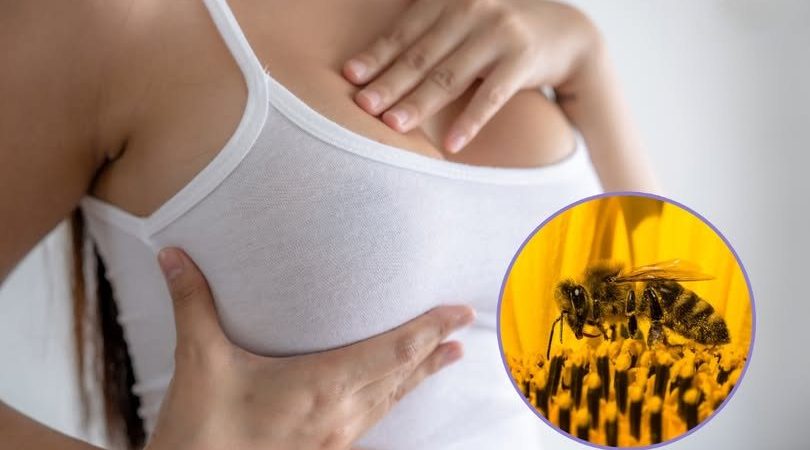The Buzz That Could Change Cancer Treatment Forever
What if something as small as a honeybee could help us take down one of the deadliest forms of breast cancer? It might sound like a wild idea, but groundbreaking research from the Harry Perkins Institute of Medical Research in Perth, Australia, suggests it’s a real possibility.
Dr. Ciara Duffy, the lead researcher behind the study, discovered that venom from honeybees can rapidly destroy aggressive breast cancer cells—including the extremely tough-to-treat triple-negative type. Published in the journal Nature Precision Oncology, the findings have the scientific community buzzing with excitement.

Understanding Triple-Negative Breast Cancer
Triple-negative breast cancer (TNBC) accounts for about 10 to 15 percent of all breast cancers. It’s known for being aggressive and resistant to many standard treatments. Unlike other breast cancer types, TNBC doesn’t have hormone receptors or high levels of HER2 protein, making it difficult to target with existing therapies.
That’s why this research is so important. A new way to attack TNBC could be a game-changer for thousands of patients.
How Honeybee Venom Targets Cancer Cells
The key to this discovery lies in a compound called melittin, which is the main active ingredient in honeybee venom. When Dr. Duffy and her team applied melittin to TNBC and HER2-enriched breast cancer cells in the lab, they found it could kill 100% of the cancer cells within 60 minutes, with minimal impact on healthy cells.
So how does it work? Melittin attacks the cancer cell’s membrane, punching holes in it and essentially causing the cell to collapse and die. That’s already impressive—but there’s more.
Video : Bee venom found to kill breast cancer cells | 9News Australia
Shutting Down Cancer’s Communication Channels
Beyond physically damaging the cells, melittin also interferes with cancer’s internal communication systems. Within just 20 minutes of exposure, the compound began blocking key signaling pathways—the ones cancer cells use to grow and multiply. This two-pronged attack made melittin incredibly effective, especially when paired with other treatments.
Combining Melittin with Chemotherapy
Dr. Duffy didn’t stop at melittin alone. She tested how it would work in combination with docetaxel, a widely used chemotherapy drug. The result? The venom made the chemo even more effective.
Because melittin creates holes in cancer cell membranes, it allowed the chemotherapy to penetrate more deeply, increasing its impact. In animal models, tumors shrank significantly faster when the two treatments were combined.

Why Perth Bees Are Special
To conduct the research, Dr. Duffy collected venom from bees in several countries, including Ireland and the UK. But the bees from Perth, Western Australia, stood out.
According to her, “Perth bees are some of the healthiest in the world,” which made their venom particularly useful for the study. The venom was collected safely—bees were put to sleep using carbon dioxide and chilled before the venom was extracted, ensuring the process was as humane as possible.
Synthetic Melittin: Reproducing Nature’s Formula
For large-scale treatment, relying solely on bee venom isn’t practical. So the team synthesized melittin in the lab—and the synthetic version performed just as well as the natural one.
That means researchers can now study melittin without needing to extract it from bees each time. This step is crucial in developing a drug that could eventually be tested in human trials.
Video : Honeybee venom found to kill cancer
What Experts Are Saying About the Discovery
Western Australia’s Chief Scientist, Professor Peter Klinken, called the findings “incredibly exciting.” He emphasized how nature continues to inspire medical breakthroughs.
“We’ve seen time and time again that compounds from the natural world can treat human diseases. This discovery adds to that legacy,” he said.
He also praised the synergy between melittin and chemotherapy, noting that when natural compounds are combined with conventional treatments, their effects can be far greater.
The Road Ahead: Promising, But Still Early
Despite the powerful results, Dr. Duffy is cautious. She’s not calling it a cure—not yet.
“There’s still a lot we don’t know,” she said. “We need to determine the safest way to deliver melittin in the body, understand its potential side effects, and test the highest doses the body can tolerate.”
In other words, while the lab results are promising, it could take years before we see this approach used in hospitals. Clinical trials, safety studies, and regulatory approvals are all necessary steps before melittin can become part of cancer treatment plans.

Nature’s Tiny Warrior: The Bee’s Role in Modern Medicine
This research is another reminder that nature holds countless secrets, waiting to be uncovered. From tree bark to fungi, coral reefs to insects—scientists continue to find potent medical compounds in the most unexpected places.
And now, thanks to the honeybee, we may be on the verge of developing a novel treatment for breast cancer that is both powerful and natural.
Conclusion: A Small Sting, A Big Step Forward
The discovery made by Dr. Ciara Duffy and her team at the Harry Perkins Institute could mark a turning point in how we approach difficult-to-treat cancers. By leveraging melittin’s dual ability to kill cells and disable their growth signals, researchers may have unlocked a powerful new tool in the fight against triple-negative breast cancer.
While there’s still plenty of research to be done, one thing is clear: this tiny sting could lead to big things in the world of medicine. The journey from bee to breakthrough is just beginning—and the future looks bright.
